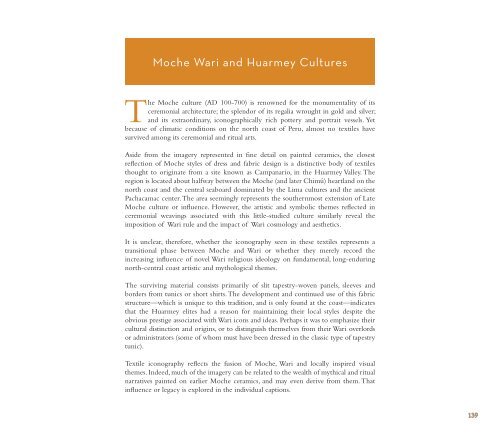Create successful ePaper yourself
Turn your PDF publications into a flip-book with our unique Google optimized e-Paper software.
Moche Wari and Huarmey Cultures<br />
The Moche culture (AD 100-700) is renowned for <strong>the</strong> monumentality of its<br />
ceremonial architecture; <strong>the</strong> splendor of its regalia wrought in gold and silver;<br />
and its extraordinary, iconographically rich pottery and portrait vessels. Yet<br />
because of climatic conditions on <strong>the</strong> north coast of Peru, almost no textiles have<br />
survived among its ceremonial and ritual arts.<br />
Aside from <strong>the</strong> imagery represented in fine detail on painted ceramics, <strong>the</strong> closest<br />
reflection of Moche styles of dress and fabric design is a distinctive body of textiles<br />
thought to originate from a site known as Campanario, in <strong>the</strong> Huarmey Valley. The<br />
region is located about halfway between <strong>the</strong> Moche (and later Chimú) heartland on <strong>the</strong><br />
north coast and <strong>the</strong> central seaboard dominated by <strong>the</strong> Lima cultures and <strong>the</strong> ancient<br />
Pachacamac center. The area seemingly represents <strong>the</strong> sou<strong>the</strong>rnmost extension of Late<br />
Moche culture or influence. However, <strong>the</strong> artistic and symbolic <strong>the</strong>mes reflected in<br />
ceremonial weavings associated with this little-studied culture similarly reveal <strong>the</strong><br />
imposition of Wari rule and <strong>the</strong> impact of Wari cosmology and aes<strong>the</strong>tics.<br />
It is unclear, <strong>the</strong>refore, whe<strong>the</strong>r <strong>the</strong> iconography seen in <strong>the</strong>se textiles represents a<br />
transitional phase between Moche and Wari or whe<strong>the</strong>r <strong>the</strong>y merely record <strong>the</strong><br />
increasing influence of novel Wari religious ideology on fundamental, long-enduring<br />
north-central coast artistic and mythological <strong>the</strong>mes.<br />
The surviving material consists primarily of slit tapestry-woven panels, sleeves and<br />
borders from tunics or short shirts. The development and continued use of this fabric<br />
structure—which is unique to this tradition, and is only found at <strong>the</strong> coast—indicates<br />
that <strong>the</strong> Huarmey elites had a reason for maintaining <strong>the</strong>ir local styles despite <strong>the</strong><br />
obvious prestige associated with Wari icons and ideas. Perhaps it was to emphasize <strong>the</strong>ir<br />
cultural distinction and origins, or to distinguish <strong>the</strong>mselves from <strong>the</strong>ir Wari overlords<br />
or administrators (some of whom must have been dressed in <strong>the</strong> classic type of tapestry<br />
tunic).<br />
Textile iconography reflects <strong>the</strong> fusion of Moche, Wari and locally inspired visual<br />
<strong>the</strong>mes. Indeed, much of <strong>the</strong> imagery can be related to <strong>the</strong> wealth of mythical and ritual<br />
narratives painted on earlier Moche ceramics, and may even derive from <strong>the</strong>m. That<br />
influence or legacy is explored in <strong>the</strong> individual captions.<br />
139







